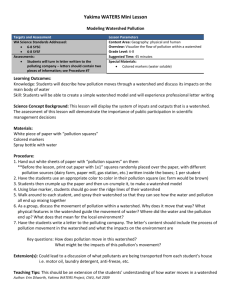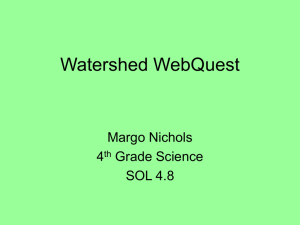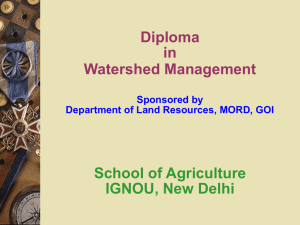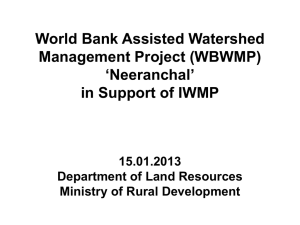Who Polluted the White River
advertisement
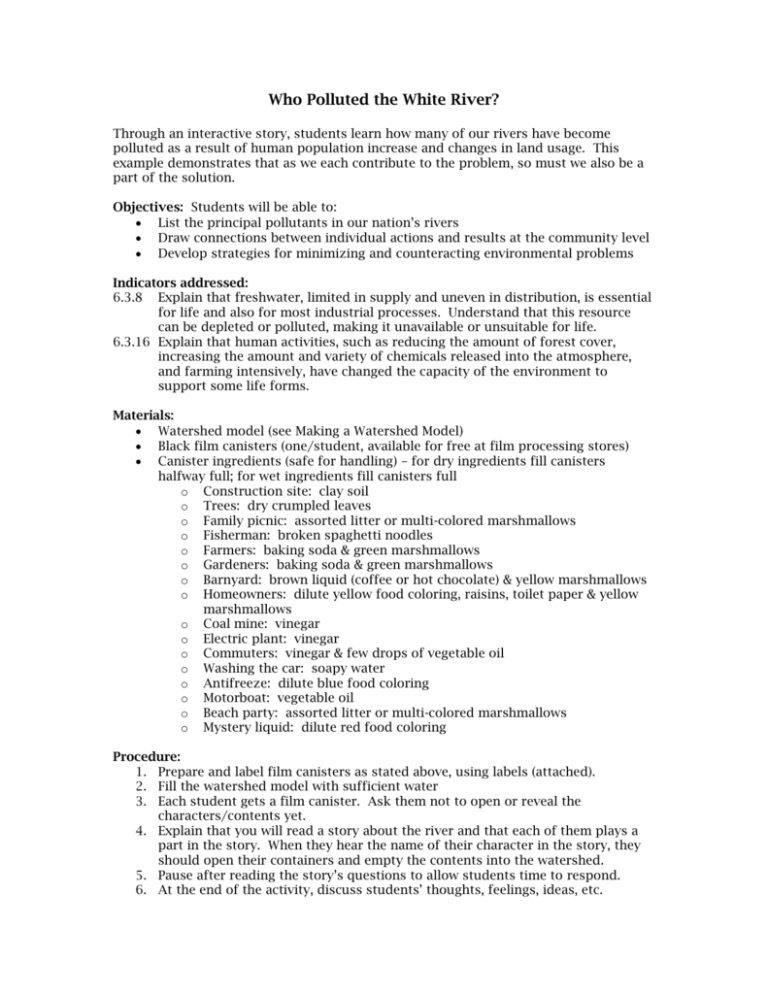
Who Polluted the White River? Through an interactive story, students learn how many of our rivers have become polluted as a result of human population increase and changes in land usage. This example demonstrates that as we each contribute to the problem, so must we also be a part of the solution. Objectives: Students will be able to: List the principal pollutants in our nation’s rivers Draw connections between individual actions and results at the community level Develop strategies for minimizing and counteracting environmental problems Indicators addressed: 6.3.8 Explain that freshwater, limited in supply and uneven in distribution, is essential for life and also for most industrial processes. Understand that this resource can be depleted or polluted, making it unavailable or unsuitable for life. 6.3.16 Explain that human activities, such as reducing the amount of forest cover, increasing the amount and variety of chemicals released into the atmosphere, and farming intensively, have changed the capacity of the environment to support some life forms. Materials: Watershed model (see Making a Watershed Model) Black film canisters (one/student, available for free at film processing stores) Canister ingredients (safe for handling) – for dry ingredients fill canisters halfway full; for wet ingredients fill canisters full o Construction site: clay soil o Trees: dry crumpled leaves o Family picnic: assorted litter or multi-colored marshmallows o Fisherman: broken spaghetti noodles o Farmers: baking soda & green marshmallows o Gardeners: baking soda & green marshmallows o Barnyard: brown liquid (coffee or hot chocolate) & yellow marshmallows o Homeowners: dilute yellow food coloring, raisins, toilet paper & yellow marshmallows o Coal mine: vinegar o Electric plant: vinegar o Commuters: vinegar & few drops of vegetable oil o Washing the car: soapy water o Antifreeze: dilute blue food coloring o Motorboat: vegetable oil o Beach party: assorted litter or multi-colored marshmallows o Mystery liquid: dilute red food coloring Procedure: 1. Prepare and label film canisters as stated above, using labels (attached). 2. Fill the watershed model with sufficient water 3. Each student gets a film canister. Ask them not to open or reveal the characters/contents yet. 4. Explain that you will read a story about the river and that each of them plays a part in the story. When they hear the name of their character in the story, they should open their containers and empty the contents into the watershed. 5. Pause after reading the story’s questions to allow students time to respond. 6. At the end of the activity, discuss students’ thoughts, feelings, ideas, etc. Who Polluted the White River? For thousands of years, people have lived on the banks of the White River. They hunted in the forests, harvested food from the wetlands, and caught fish in the river. They used the river for irrigation for their crops and used it as a means of transportation. They depended upon the river for their survival. Question: Imagine that this watershed is the White River about 500 years ago. Describe how it looks to you. If you were a Native American living there, would you drink this water? Eat fish from it? Swim in it? One of the first European explorers to visit the river kept a journal of his discoveries. He wrote about the Native American villages, the tributaries of “sweet water”, and the many fish that he and his crew tried to scoop out of the river. Soon colonists began to arrive. They found fertile land for farming, forests teeming with wildlife and wood, and a river that provided ample food and water. It was an outstanding environment for settlement, and the colonists prospered. How do you think the colonists used the river? Do we use it the ways today? The river has changed tremendously since it was first explored. This is the story of those changes. Listen for the name of the character printed on your canister. When you hear your character names, open the canister and dump its contents into the watershed. Years went by and occasional storms drenched the area. High winds whipped the trees and blew leaves into the river. Gradually, the city of Indianapolis grew on the banks of the White River. Developers cleared wetlands and forests to build houses and businesses. Rains washed loose soil from construction sites into the river. Is this water safe to drink? (If “no”, ask is the river had leaves or soil in it when explorers first drank from it). Would you swim in it? Is it safe for wildlife? At first, the city was small. Upstream, farmers planted crops to feed the city’s growing population. Some of these crops grew right up against the banks of the river, and fertilizers washed off the land and into the water. Other farmers raised pigs and cattle and other animals in their barnyard. As farming became more modernized, farmers gave their animals antibiotics and growth hormones, which also entered the water with the manure. The creek flows into the river. As rainwater drained out of the barnyard, it carried some of the manure into a little creek behind the farm. Would you drink this water now? Would you swim in it? Go boating on it? Is it safe for wildlife? As the city grew, more people began to move to the nearby countryside. The rural houses are not connected to the city sewer system. Waste water from these houses flows into septic tanks under the ground. A few homeowners have not maintained their septic tanks, and untreated sewage seeped into the river. To meet the electricity needs of the city, area officials decided that they would need to generate more power. Far upstream, a coal mine was dug. Rainwater drained down into the mine shaft and soaked the piles of waste and scraps from mining. This made the rainwater become acidic with the sulfur that is in the coal. Then the acidic water trickled back out into the river. To burn the coal in order to produce power, an electric power plant was built along the river. Gases coming out of the smokestack combine with the moisture in the air to form acids. The pollution falls back to the ground as acid rain. Would you drink this water now? Would you swim in it? Go boating on it? Could wildlife live in water that is so acidic? Now, Indianapolis is a large metropolitan area. Traffic congestion is a big problem for commuters who drive cars to get to and from places. Car exhaust fumes (similar to the power plant fumes) cause acid rain. If a car is not kept in good condition, it might also leak oil or other fluids which will be washed off the pavement and into the river with the next rain. And how do the residents of the city and its suburbs spend their time? In one neighborhood, lots of gardeners are out working in the yards. Many of them use insecticides and pesticides to maintain their gardens and keep their lawns looking nice. The next rain will wash these toxins into the streams and river. One father is teaching his daughter how to change the antifreeze in their vehicle. They pour out the used antifreeze into the driveway. Antifreeze is sweet-tasting and can poison animals that drink it. It may also get in the watershed and poison fish and other wildlife. Down the street, a boy washes the family car. The soapy water rushed down the driveway into the storm drain, which empties into the river. The grease and grime on the car contains asphalt from the roads, asbestos from the brakes, rubber particles from the tires, toxic metals and rust. If the boy had gone to a local car wash, the water would have been treated before it returned to the river. On another block, a man is cleaning out his garage. He finds a rusty old can with a tattered skull and crossbones label on it. What could it be? It looks hazardous and he wants to get rid of it before someone else gets into it. He decides to pour it down the drain by the curb. The mysterious liquid is out of the garage, but headed straight for the river. On nice days, many people head down to the river for recreation. Some go out onto the river in their motorboats, leaking engine oil into the water. On the shore, some friends have spread out blankets for a beach party. Many families are picnicking too. Some of these people have left trash on the shore. With the next storm or wind, the trash will wash into the river. In a small cove, a person fishing snags a hook on a log, and breaks off the fishing line. Would you drink this water now? Would you swim in it? Go boating on it? Could wildlife live in water that is so polluted? Discussion questions (Answers): Who polluted the White River? (Everyone played a role.) What affect did the increasing population have on the health of the river? (More people meant fewer wetlands and forests which filter water and hold the soil in place; more cars, less natural space, more toxins going into the water, etc.) Can you think of any ways that population increases helped the river? (Higher population densities lead to more efficient use of resources, stronger environmental laws, public resources like sewage treatment plants, etc.) Think about the pollution contained in your canister. Could something be done to prevent that type of thing from entering the water? How? (Answers will vary.) [Challenge students to come up with ways to clean up the water in the watershed; after all, everything has to go somewhere! (Solids can be strained or filtered, absorbent cotton can be used, etc.)] Once this type of pollution has entered the river, how can we get it out? How can we clean up the river? It is easier to prevent pollution or clean it up later? What can we do to prevent pollution? What could each of us do to help improve the health of our river? (Biking or walking instead of driving; picking up litter, dispose of fluids properly, growing or buying foods that been grown with pesticides, pull weeds in the yard instead of spraying them, etc.) Extensions/Suggestions: Use a container of water to represent the river instead of a watershed model Have students write their own story about the watershed Students can research actual pollution events in their or other watersheds Assessment: Working in groups, ask students to create a plan to clean up the river and prevent future pollution. Who would be involved? How would they do it? What kinds of resources would they need? How could they get more community people involved? Grade with a rubric. Acknowledgement: This activity was originally developed by Hard Bargain Farm Environmental Center, Accokeek, MD and adapted from Population Education Training.

